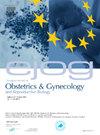Risk of cervical stenosis after cervical excision in postmenopausal patients
IF 2.1
4区 医学
Q2 OBSTETRICS & GYNECOLOGY
European journal of obstetrics, gynecology, and reproductive biology
Pub Date : 2025-03-07
DOI:10.1016/j.ejogrb.2025.03.017
引用次数: 0
Abstract
Objective
Cervical excision may cause cervical stenosis, leading to suboptimal follow-up of dysplasia and delayed diagnosis of cervical and endometrial pathology. This study aimed to quantify the risk of stenosis development after electrosurgical cervical excision in postmenopausal patients.
Methods
Retrospective cohort study based on data collection from electronic medical records and the Danish National Pathology Data Bank. Patients aged ≥45 years who underwent electrosurgical cervical excision in the Gynecological Department, at Randers Regional Hospital from1st of January 2012 to 31st December 2019 were included. Primary outcome was risk of cervical stenosis following cervical excision.
Results
Of the 567 cervical excisions conducted within the study period, 300 patients (52.9 %) met the inclusion criteria. Among these, 79 postmenopausal patients (26.3 %) developed cervical stenosis after cervical excision. Patients with stenosis were significantly older (median 64 years) compared to those without stenosis (median 61 years) (p = 0.004). Patients aged >60 years at the time of cervical excision exhibited an increased risk of cervical stenosis (relative risk 1.51 (95 % confidence interval 1.08–2.18)) compared to those ≤60 years.
Conclusion
More than one in four postmenopausal patients experienced the development of cervical stenosis following cervical excision. Patients should be adequately informed of the possible risk of cervical stenosis development prior to undergoing diagnostic or therapeutic cervical excision procedure.
求助全文
约1分钟内获得全文
求助全文
来源期刊
CiteScore
4.60
自引率
3.80%
发文量
898
审稿时长
8.3 weeks
期刊介绍:
The European Journal of Obstetrics & Gynecology and Reproductive Biology is the leading general clinical journal covering the continent. It publishes peer reviewed original research articles, as well as a wide range of news, book reviews, biographical, historical and educational articles and a lively correspondence section. Fields covered include obstetrics, prenatal diagnosis, maternal-fetal medicine, perinatology, general gynecology, gynecologic oncology, uro-gynecology, reproductive medicine, infertility, reproductive endocrinology, sexual medicine and reproductive ethics. The European Journal of Obstetrics & Gynecology and Reproductive Biology provides a forum for scientific and clinical professional communication in obstetrics and gynecology throughout Europe and the world.

 求助内容:
求助内容: 应助结果提醒方式:
应助结果提醒方式:


